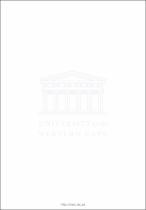Evaluation of two radiographic scoring systems used to monitor caries progression in deciduous teeth
Abstract
The investigation was designed to evaluate the scoring systems of
pitts (1984), and that of Murray and Majid(1978), when used to
monitor caries progression in deciduous teeth. The evaluation.was
based on the reproducibility and discrlininatory ability of the two
systems.
The Reproducibility Study was designed to compare the reproducibility
of the two systems, and in addition, to illustrate, firstly the use
of the subject as the sampling unit in measuring reproducibility, and
secondly, a more sensitive method of measuring reproducibility when
analysing caries progression data.
The Progression Study was designed to
discriminatory ability. In addition the
compare
use of the
the effect on
subject as the
sampling unit in monitoring caries progression was illustrated in the
analysis of this part of the investigation.
A sub-sample of the posterior bitewing radiographs of 301, 5 year old
children from a Duraphat clinical trial (Murray et al. 1977, Murray
and Majid 1978) were re-examined. For the Reproducibility Study 150
sets of radiographs were examined a total of 4 times, (repeated
examinations for each method). For the Progression Study three serial
bitewing radiographs of 50 children were examined using the two
methods.
For the Reproducibility Study, Kendall's Tau-B was used as an
approxlination of the weighted Kappa as a measure of reproducibility.
While the pitts method appeared to be more reliable, the difference
.between the tYK>methods was not significant( p~ 05). The surface cannot
be used as an independent unit in measuring reproducibility. A method
using the subject as the sampling unit was illustrated. Attention was
drawn to the need to develop a measure of reproducibility for
progression studies which would take into account the magnitude of the
disagreement (instead of just disagreement) into the overall index of
reproducibility. The use of weighted Kappa is suggested as a more
appropriate measure of reproducibility.
In the Progression Study Method 1 is more sensitive to the various
stages of the disease process and provides a more complete overall
picture of the carious process. The proportion of enamel lesions
recorded for Method 1 were consistantly higher than that for Method
2. The behaviour of outer and inner enamel lesions differed
considerably and Method 1 allowed the behaviour of these lesions to
be considered separately.
The progression rates were found to be faster with Method 2. With
Method 1 30% of enamel lesions per subject had progressed to
dentine or been filled 12 months later, the corresponding figure for
Method 2 was 50%. Method 2 by excluding outer enamel lesions
introduces two biases. The combination of these biases favour
overestimating the proportion of lesions deemed to have progressed.
The use of Method 2 may lead to the unnecessary loss of valuable
data; more surfaces were excluded as being unreadable because of
overlap. The average proportion of surfaces per subject recorded as
unreadible due to overlap was 7% at baseline, 8% at 12 months and 8%
at 24 months, the corresponding figures for Method 2 were 13%, 13%
and 22% for Method 2. Method 1 thus appears to offer some advantages.
The use of the subject as the sampling unit in analysing caries
progression data offers a mnnber of advantages when canpared to the
use of the surface as the sampling unit. The findings of the study
indicate the proportions of high risk subjects (subjects in whom a
large proportion of lesions progressed in a given time period) was low.
With Method 1 in only 11% of the subjects did 80-100% of the enamel
lesions progress after 12 months.
The findings indicate that the Pitts system is the more useful
scoring system in studies monitoring caries progression in deciduous
teeth.

